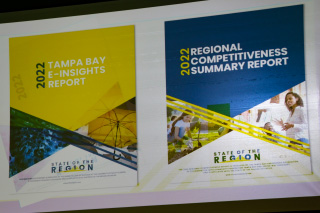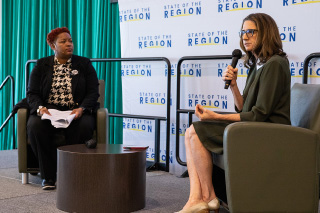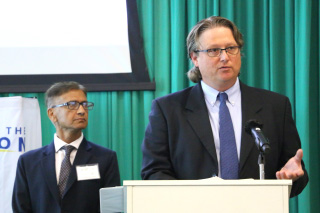News Archive
USF Researchers and Business Leaders Unpack Key Tampa Bay Metrics at “State of the Region” Event
By Elizabeth L. Brown

ST. PETERSBURG (April 13, 2022) – Researchers from the University of South Florida Muma College of Business and Tampa Bay Partnership unveiled on Wednesday findings from two data-driven reports examining how the eight-county region stacks up against its demographic peers.
The results showed a mixed bag of takeaways. On the positive side, the region has largely recovered economically from the COVID-19 pandemic. However, some not-so-rosy indicators show there is a lot of work ahead if the area wants to stay competitive in innovation and entrepreneurship, health care, and education.
“It’s important that we’re honest, so we know what the challenges are ahead,” said Moez Limayem, Lynn Pippenger Dean of the Muma College of Business. “Overall, we are doing OK, but is OK good enough?”
“As always, there is some good news and some sobering news. But when we know our challenges, we can solve our challenges. Now is when the work begins. Our goal is to make our community better,” he said.
Among the dual reports’ key findings: the region lagged in all innovation indicators, saw high school graduation rates improve, suffered a drop in K-12 student performance from pre-pandemic levels, and ranked among the top in mental health and addiction-related 211 calls against the 19 comparison metropolitan areas.
The insights were drawn from the 2022 Regional Competitiveness Report — published by the Tampa Bay Partnership in January in collaboration with Community Foundation Tampa Bay and United Way Suncoast — and the Tampa Bay E-Insights Report, a 90-page booklet featuring real-time data compiled by researchers from the Muma College of Business’ Center for Analytics and Creativity.
Regional business leaders and educators unpacked the two reports’ key takeaways from three main fronts — health care, innovation and entrepreneurship, and education — at the “State of the Region” community luncheon held on April 13 in the student center ballroom on the USF St. Petersburg campus. The event, postponed from January due to the pandemic, drew about 250 people.
This is the fifth year USF and Tampa Bay Partnership have teamed up to assemble the comprehensive reports. The reports offer a glimpse of the region’s standings by using comparative data from 19 similar-sized metro areas as a benchmark.

Bemetra Simmons, president and CEO of the Tampa Bay Partnership, said the reports help community leaders better understand the region and move the needle on its biggest issues.
“The data hits some high notes regarding our economic growth and the attractiveness of our community to both residents and businesses,” she said. “But the data also shows room for improvement because we want to create a community where everyone prospers, where no one is left behind.”
The publications also serve as a roadmap for local and state legislators, public and private business leaders, and academic stakeholders to improve the region’s economic health and growth.
“USF has a responsibility to be a catalyst for economic growth, to fuel our region’s upward trajectory. We also have a responsibility to be sure that the growth is equitable and accessible,” said USF President Rhea Law.
“What we have learned today is that this community cares,” she said. “Partnerships make things better. Let’s jointly make investments. This can serve as a call to action for each individual and organization to identify their own role in helping to move our region forward.”
Health Care Data
On the health care front, researchers showed that one in eight Tampa Bay residents do not have health insurance coverage. In a region of 5 million people, that’s equivalent to nearly 625,000 residents without health insurance.
In addition, the Tampa Bay region has consistently performed poorly in both the affordability and availability of health care.
On a positive note, the region’s availability of health care, measured in the population-to-primary care provider ratio, has been improving, said Shivendu Shivendu, an associate professor at the USF Muma College of Business.
“We are in the middle of the pack,” he said. “We are also in the bottom half. That means there is a lot of work to be done here.”
Digging a little deeper into mental health care, Shivendu noted that the region registered the third-highest number of mental health and addiction-related 211 calls per 1,000 individuals among the 19 comparison metro areas. Tampa Bay placed third, behind Miami and Orlando, which ranked No. 1 and 2, respectively.

Dave Sobush, senior director of policy and research for the Tampa Bay Partnership, added that when you look at the data from the Center for Disease Control’s Social Determinants of Health, there are some alarming data points.
For example, one in eight youth aged 16 to 24 are neither enrolled in school nor employed and are considered “disconnected youth.” The racial disparities are even more unsettling. Black youth are 52% more likely to be “disconnected.”
John Couris, CEO of Tampa General Hospital, shed more light on the region’s recovery from the COVID-19 pandemic from a practitioner’s perspective. He cautioned that the dire numbers are not all that bad.
“We’re victims of our own success,” he said. “Health care is a very interesting business. Health care is one of the few industries where the larger you get, the more expensive you get. We’ve got to provide better access to care.”
“It’s a great problem to have, that we’re growing as a region, but it’s still a problem to solve. We all have to do a better job with health equity. We need to be better collaborators,” Couris said, adding that at Tampa General Hospital, they believe it’s every person’s “God-given right” to have access to world-class health care.
Innovation and Entrepreneurship Trends
On the innovation and entrepreneurship side, there is sobering news. The innovation indicators measure how a community and its institutions are generating new ideas and the market’s reception of those ideas.
While USF is ranked No. 8 among American public research universities and No. 16 among all universities worldwide in generating new patents, the region’s performance in terms of patents per 10,000 residents and USF’s spending on research and development is relatively low over the years.
“Tampa Bay lags most of the other regions, said Sobush. “The top patent generating metros average seven times more patents on a per capita basis compared to Tampa Bay.”
And while regional patent production fell, small business awards for innovation and technology transfer research increased. Unfortunately, the region is still ranked at the bottom among its demographic counterparts.
For instance, the Tampa Bay region’s small business innovation research awards per capita were $1.41 while the top-performing region, Raleigh-Durham, posted a $38.69 per capita award.
Elizabeth Pritchard, the founder of White Rock Data Solutions, a consulting firm providing innovative solutions for managing and commercializing data, offered her take on how the region can foster innovation.
“It’s more about trying to figure out how to get innovation in,” she said. “The short answer is really identifying the innovators and really protecting the innovators. We need to protect the early adopters by creating an environment where they can succeed.”
Education Trends
When it comes to education, the regional data showed some bright spots, but overall, student performance was on the decline.
Tampa Bay K-12 student performance — across a variety of assessments — fell from pre-pandemic levels.
On a positive note, the region’s high school graduation rates — for all students as well as the economically disadvantaged — improved over the prior year. The high school graduation rate jumped to 89%, bumping the area’s ranking up four spots to No. 11.
Sobush offered a word of caution. These graduation rates for the 2019-2020 school year were during the pandemic when students were out of school and learning remotely. State leaders temporarily removed some testing requirements for graduation.
“Like many of the indicators affected by pandemic response and behavior, we’ll be looking closely at the data to see if following years continue the positive trend,” he said.
In addition, the pandemic appears to have affected timely higher education completion, because the degree production per 10,000 residents rate dropped and pushed the region’s ranking down to No. 15 among its demographic peers.
And while higher education completion slid, the number of students graduating with degrees in science, technology, engineering, and mathematics continued to rise.
Another alarming trend showed that kindergarten readiness and third-grade reading pass rates were low. Only half of kindergarteners have age-appropriate literacy skills and only half of third-graders are reading at level, Sobush said.
These numbers are key because that’s an important milestone. Instructional methods largely change after third grade. Students spend less time learning to read and more time reading to learn.
“The downstream impacts of this key educational checkpoint are pretty significant in terms of future opportunities and earnings,” he said. “If we want to think of ways to really impact regional competitiveness and prosperity, one place to start is solving gaps like these and unlocking the human potential in each young person.”
A Call to Action
Although the 90-minute program offered some discouraging numbers on where the Tampa Bay region is headed and how it measures up against 19 comparable communities, business leaders and educators said it was important to not shy away from the numbers.
Instead, they challenged participants to use the research and data in the decision-making process, to answer its call to action, and to work together to improve the community as a whole.
“What we’ve heard today is both exciting and a little bit concerning,” said Chad Loar, regional president for West and Central Florida at PNC Bank and chair of the Tampa Bay Partnership. “Our region is a place where people and businesses want to be.”
“However, we see alarm bells that the affordability of our region may begin to hamper growth,” he said. “It’s becoming clear that we need to take action if we want our growth to benefit every resident in every corner of this region.”
Limayem encouraged participants to use the multi-dimensional quantitative report as a roadmap to take actionable steps.
“We strive to be a resource for our business community,” he said. “Our goal is to take a scientific approach and share relevant research to improve the economic health of the region. We want to make the Tampa Bay area a very attractive destination for both businesses and the people who work in them.”